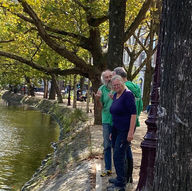
The EcoWal:
a green gift in honor of Amsterdam 750
The EcoWal: a green oasis for people, plants and animals
The EcoWal (wal meaning shore) is a “nature-inclusive” wall placed against the quay. It consists of an invisible part (underwater) and a visible part (above water).
Underwater, from the bottom of the canal up to the waterline, lies a structure made of recycled stones and bundles of branches.
At the waterline, there is a so-called planting mat made of coconut fibers, where various native bank and aquatic plants are planted. Their roots can grow through the mat.
Besides the coconut mat, we also placed a planting mat made of untreated wool from "Drentse heide" sheep, from the flock in the Goois Nature Reserve. This is a test to see how plants take root in wool. And what did we find? The plants in the wool grow incredibly well!
You will also see a piece of cork floating on the water. This is a so-called fauna resting place, designed especially for birds. Several birds have already visited, such as the heron, great crested grebe, coot and mallard. Who will be the first to build a nest here?


What do all these various elements do?
-
The plants purify the water with their roots.
-
The spaces between the stones, the rough surfaces, the branches, and the roots offer safe shelter for fish and various aquatic animals.
-
The underwater branch bundles serve as a place for fish to lay their eggs.
-
The plants growing above the water green the quay wall, increase biodiversity, and attract insects such as dragonflies.
In this way, the EcoWal creates a lively natural habitat both above and below the water. Over time, life will flourish above the surface, but also in the hidden world: the rich life in and around the water.
Where can you find the EcoWallen?
All EcoWallen are located in the Singelgracht: next to the dock of De Nederlandsche Bank (DNB) and along the pedestrian boulevard between Ferdinand Bolstraat and Ruysdaelkade.
Next to DNB there are two EcoWallen, actually three, because there is also a small one. Along the pedestrian boulevard, there is a very long EcoWal.


Unique in Amsterdam, inspired by Utrecht
The EcoWal is unique in Amsterdam, but not in the Netherlands. The very first was created in Utrecht, which served as our inspiration. Ours are much wider and longer.
Even better: this special design was created by Lies König and Ben Nijssen, both part of Stichting VergroeningSingel030, with a clear commitment to nature.


Why did we choose this gift?
For several reasons:
-
We want more greenery! Along the quays lies great potential; Amsterdam has 600 km (!) of quay walls
-
We want to increase biodiversity, both above and below the water
-
We want to contribute to clean water, the basis of all life on Earth
-
We want to provide a habitat for fish, mussels, and other aquatic animals
-
We want to raise awareness of the hidden life beneath our feet
-
We want to add ecological and social value
But I hardly see anything yet, is that right?
That’s right! The plants still need time to grow. In autumn and winter they go dormant. From March onward, they will develop further, and you will see growth. Hopefully, the first marsh marigold will bloom in April!
Curious about the full list of plants in the EcoWal? Send us an email, and we’ll share the planting list and flowering times. Each location has a different planting plan, since one spot is in full sun and the other is not. Please see below a illustration of how it could look like in time.




Will you monitor and maintain it yourselves?
Absolutely! We will monitor both, above and below the water: which plants and animals settle here, how the water quality develops, which birds appear and more. We’ll do this together with students, researchers, educational programs, ecologists, and other interested people. It will be a great adventure! Would you like to join and contribute, we would love to have more people on board! Please send us an email.
And who takes care of the plants, making sure no invasive species or waste gets in?
That’s the job of our two EcoRangers: David and Stefan. We are very happy they are taking this on. You can recognize them by their The Green Mile sweater.
And the mesh around the EcoWallen?
That’s there for the first two years to protect the plants, so they can grow safely and undisturbed.





























